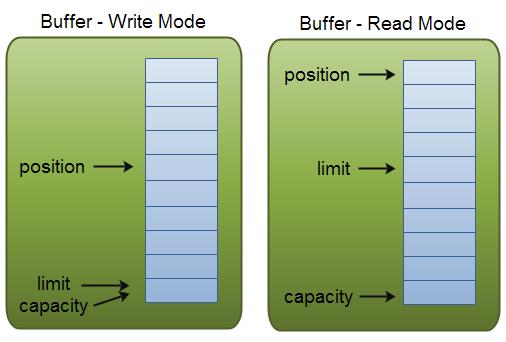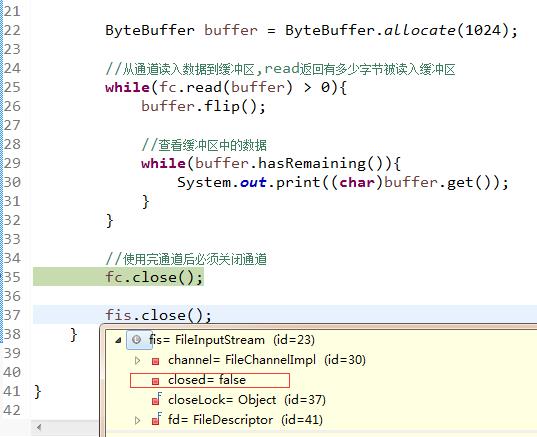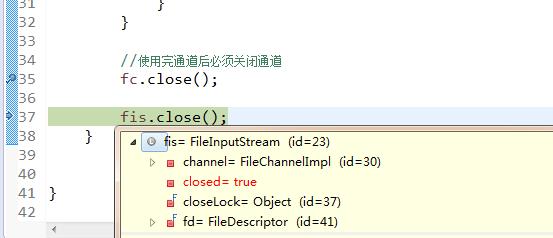JAVA NIO学习笔记
Posted insaneXs
tags:
篇首语:本文由小常识网(cha138.com)小编为大家整理,主要介绍了JAVA NIO学习笔记相关的知识,希望对你有一定的参考价值。
概述
Java NIO(New IO)是一个可以替代标准Java IO API 的IO API(从Jav a 1. 4开始),Java NIO提供了与标准IO不同的IO工作方式。由以下几个核心的部分组成:
- Buffers(缓冲区)
- Ch an n el s(通道)
- Sel ect ors(多路复用器)
- Buffers(缓冲区 )
除布尔类型外,每个基本类型数据都有对应的特定Buffer对象,如(ByteBuffer, CharBuffer, DoubleBuffer,FloatBuffer, IntBuffer, LongBuffer, ShortBuffer)。而Buffer是所有这些的父类。Buffer可以被理解为一个数据容器,或者说就是一个缓冲区,用来存放数据。Buffer
有四个重要的属性,分别是capacity(容量)、limit(限制)、position(位置)、mark(标记)。
- capacity:表示该缓冲的容量。
- limit:表示往Buffer中读或写时可以到的最大位置,当超出limit时,将会抛出异常。
- position:表示当前所在的位置。 mark:用来备份position,以便在之后可以重新退回position的位置。
- 如下图所示:

- 上述四种属性的关系是:0 <= 标记 <= 位置 <= 限制 <= 容量。
- 每个缓冲区都是可读,但并不是每个缓冲区都是可写的。以ByteBuffer为例,可以通过ByteBuffer.asReadOnlyBuffer()方法创建一个只读的缓冲区(asReadOnlyBuffer是一个抽象方法,具体实现交由其子类实现)。当对只读缓冲区进行写入操作时,会抛出ReadOnlyBufferException异常。另外,缓冲区并非是线程安全的,当多个线程操作缓冲区时,需要进行必要的同步操作。
- ByteBuffer重要api:
| 方法名 | 返回类型 | 说明 |
| capacity() | int | 返回此缓冲区的容量 |
| clear() | Buffer | 清除此缓冲区,会将limit设置为capaticy,将position设置为0,但是并不会清空Buffer中的内容,详见示例一 |
| flip() | Buffer | 反转此缓冲区,将limt设置为position的值,将position设置为0,一般用于读写转换 |
| limit() | int | 返回此缓冲区的limit |
| limit(int newLimit) | Buffer | 设置此缓冲器的limie,返回Buffer自身 |
| mark() | Buffer | 设置mark,返回Buffer自身 |
| position() | int | 返回position |
| position(int newPosition) | Buffer | 设置position,返回Buffer自身 |
| hasRemaining() | boolean | 判断position是否已经到达limit |
| remaining() | int | 返回limit和position之前的偏移量 |
| reset() | Buffer | 将posistion设置为mark的位置 |
示例一:
1 public class BufferExercise1 { 2 public static void main(String[] args){ 3 ByteBuffer buffer = ByteBuffer.allocate(1024); 4 5 buffer.put("hello world".getBytes()); 6 buffer.flip(); 7 //标记 8 buffer.mark(); 9 while(buffer.hasRemaining()){ 10 byte b = buffer.get(); 11 System.out.println("position " + buffer.position() + ": " + (char)b); 12 } 13 System.out.println("before clear:"); 14 System.out.println(buffer.position()); 15 System.out.println(buffer.limit()); 16 17 buffer.clear(); 18 System.out.println("after clear:"); 19 System.out.println(buffer.limit()); 20 System.out.println(buffer.position()); 21 System.out.println((char)buffer.get(3)); 22 } 23 }
Channel(通道 )
Channel类主要的分为四种:
- FileChannel(用于文件读写的通道)
- DatagramChannel(可以收发UDP的通道)
- SocketChannel(连接TCP Socket的通道)
- ServerSocketChannel(可以监听到新的SOCKET连接的通道)
介绍这四种的Channel前,我们先由底层开始认识下主要的接口(注:以下介绍的都为interface)。
- Channel接口:继承了IO包中的Closeable接口,是通道的基本定义。通道是可处于打开或关闭状态的。因此该接口定义了close()方法用于关闭接口和isOpen()方法判断通道是否处于打开状态。一般情况下,通道都是线程安全的。
- InterruptibleChannel:实现此接口的通道是可异步关闭的。当一个线程阻塞在实现了该接口通道的I/O操作上,另一个接口可以调用该通道的close方法关闭。或者是调用阻塞线程的interupt方法关闭通道,并设置阻塞线程为可中断状态。
- WriteableByteChannel和ReadableByteChannel:分别定义了通道的写和读字节的操作。
- ByteChannel:继承了WriteableByteChannel和ReadableByteChannel。并未提供新的方法,只是对字节通道做了统一。
- GatteringByteChannel和ScatteringByteChannel:分别继承了WriteableByteChannel和ReadableByteChannel,提供了集中写(由多个缓冲区写入通道)和分散读(将通道中的数据依次读入多个缓冲区,一个缓冲区满了后开始填充下一个缓冲区)。
下面来介绍四种主要的Channel。
- FileChannel:用于读取、写入、映射和操作文件的通道。实现了ByteChannel,GatheringByteChannel和ScatteringByteChannel。因此具有读写甚至是批量读写的字节的功能。此外,它还提供了对文件的特定操作。
先通过代码了解一下FileChannel的一些基本用法。
1 public class FileChannelExer1 { 2 3 public static void main(String[] args) throws IOException { 4 // TODO Auto-generated method stub 5 File file = new File("E:\\\\exercise\\\\learnNIO\\\\data.txt"); 6 7 FileInputStream fis = new FileInputStream(file); 8 9 FileChannel fc = fis.getChannel(); 10 11 System.out.println(fc.position()); 12 13 ByteBuffer buffer = ByteBuffer.allocate(1024); 14 15 //从通道读入数据到缓冲区,read返回有多少字节被读入缓冲区 16 while(fc.read(buffer) > 0){ 17 buffer.flip(); 18 19 //查看缓冲区中的数据 20 while(buffer.hasRemaining()){ 21 System.out.print((char)buffer.get()); 22 } 23 } 24 25 //使用完通道后必须关闭通道 26 fc.close(); 27 28 fis.close(); 29 } 30 31 32 }
这里我们调用流的close()方法是想确认下通道的关闭是否会关闭流。


对比通道close()方法的执行前后,我们可以发现在通道关闭时,流也被关闭了。
我们在来测试下从InputStream中获取的通道是否为可写的:
public class FileChannelExer2 { public static void main(String[] args) throws IOException { // TODO Auto-generated method stub File file = new File("E:\\\\exercise\\\\learnNIO\\\\data.txt"); FileInputStream fis = new FileInputStream(file); FileChannel fc = fis.getChannel(); System.out.println(fc.position()); //验证从InputStream获取的Channel是否为可写 ByteBuffer buffer = ByteBuffer.allocate(1024); buffer.put("say something".getBytes()); //抛出NonWritableChannelException异常 fc.write(buffer); System.out.println("ater write,the position is " + fc.position()); //使用完通道后必须关闭通道 fc.close(); } }
结果是抛出了异常,同理从FileOutputStream中获取的Channel是不可读的。
如果想要可读写的Channel,我们可以通过RandomAcessFile来获取。
1 public class FileChannelExer4 { 2 3 public static void main(String[] args) throws IOException { 4 File file = new File("E:\\\\exercise\\\\learnNIO\\\\data.txt"); 5 //以读写的方式打开 6 RandomAccessFile randF = new RandomAccessFile(file, "rw"); 7 8 9 FileChannel fc = randF.getChannel(); 10 11 System.out.println(fc.position()); 12 13 ByteBuffer buffer = ByteBuffer.allocate(1024); 14 15 while(fc.read(buffer) > 0){ 16 buffer.flip(); 17 System.out.println(fc.position()); 18 19 while(buffer.hasRemaining()){ 20 System.out.print((char)buffer.get()); 21 } 22 } 23 24 buffer.clear(); 25 26 buffer.put("say something".getBytes()); 27 28 buffer.flip(); 29 30 fc.write(buffer); 31 32 //使用完通道后必须关闭通道 33 fc.close(); 34 } 35 36 }
- DategramChannel(收发UDP的通道)
介绍下简单的用法:
1 public class DatagramChannelExer1 { 2 public static void main(String[] args) throws InterruptedException{ 3 Thread server = new Thread(new Server()); 4 server.start(); 5 6 Thread.sleep(1000); 7 8 Thread client = new Thread(new Client()); 9 client.start(); 10 11 } 12 } 13 14 class Server implements Runnable{ 15 16 @Override 17 public void run() { 18 try { 19 //创建DatagramChannel的操作时用静态的open方法,此时获得DatagramChannel的对象已经为打开状态 20 DatagramChannel dc = DatagramChannel.open(); 21 SocketAddress sc = new InetSocketAddress("localhost", 9988); 22 //为了建立连接,需要对dc的socket与监听的端口进行绑定 23 dc.socket().bind(sc); 24 //创建缓冲区 25 ByteBuffer buffer = ByteBuffer.allocate(1024); 26 27 //设置是否为阻塞模式,将会影响Channel的recive行为 28 //阻塞模式下,如果没有监听到可用的消息,recive()将会阻塞直到获取到可用消息 29 //非阻塞模式下,如果没有监听到可用的消息,recive()将会立即返回null 30 //dc.configureBlocking(true); 31 32 while(true){ 33 //recive会将收到的消息读到buffer中,若果buffer已经被写满,多余的信息将会被丢弃 34 //recive返回的对象是发报源的一些信息 35 SocketAddress address = dc.receive(buffer); 36 if(address != null){ 37 System.out.println(address); 38 } 39 40 buffer.flip(); 41 while(buffer.hasRemaining()){ 42 System.out.print((char)buffer.get()); 43 } 44 buffer.clear(); 45 46 } 47 } catch (IOException e) { 48 e.printStackTrace(); 49 } 50 51 } 52 } 53 54 class Client implements Runnable{ 55 56 @Override 57 public void run() { 58 try { 59 DatagramChannel dc = DatagramChannel.open(); 60 61 SocketAddress target = new InetSocketAddress("localhost", 9988); 62 63 ByteBuffer buffer = ByteBuffer.allocate(1024); 64 65 buffer.put("hello world".getBytes()); 66 buffer.flip(); 67 68 for(int i=0; i<10; i++){ 69 //让buffer从0开始再重新读 70 buffer.position(0); 71 //Datagram发送报文不需要手动绑定socket,只需要指定目标SocketAddress 72 dc.send(buffer, target); 73 Thread.sleep(1000); 74 } 75 76 //关闭通道 77 dc.close(); 78 } catch (IOException e) { 79 e.printStackTrace(); 80 } catch (InterruptedException e) { 81 // TODO Auto-generated catch block 82 e.printStackTrace(); 83 } 84 85 } 86 87 }
以上代码我们是用send和receive方法取代了传统Channel的基本write和read方法,再来试试用write和read是否可以达到同样的效果。
1 public class DatagramChannelExer2 { 2 public static void main(String[] args) throws InterruptedException{ 3 Thread server = new Thread(new Server2()); 4 server.start(); 5 6 Thread.sleep(1000); 7 8 Thread client = new Thread(new Client2()); 9 client.start(); 10 11 } 12 } 13 14 class Server2 implements Runnable{ 15 16 @Override 17 public void run() { 18 try { 19 //创建DatagramChannel的操作时用静态的open方法,此时获得DatagramChannel的对象已经为打开状态 20 DatagramChannel dc = DatagramChannel.open(); 21 SocketAddress sc = new InetSocketAddress("localhost", 9988); 22 //为了建立连接,需要对dc的socket与监听的端口进行绑定 23 dc.socket().bind(sc); 24 //创建缓冲区 25 ByteBuffer buffer = ByteBuffer.allocate(1024); 26 27 System.out.println(dc.isConnected()); 28 while(true){ 29 dc.read(buffer); 30 31 buffer.flip(); 32 while(buffer.hasRemaining()){ 33 System.out.print((char)buffer.get()); 34 } 35 buffer.clear(); 36 37 } 38 } catch (IOException e) { 39 e.printStackTrace(); 40 } 41 42 } 43 } 44 45 class Client2 implements Runnable{ 46 47 @Override 48 public void run() { 49 try { 50 DatagramChannel dc = DatagramChannel.open(); 51 52 SocketAddress target = new InetSocketAddress("localhost", 9988); 53 54 ByteBuffer buffer = ByteBuffer.allocate(1024); 55 56 buffer.put("hello world".getBytes()); 57 buffer.flip(); 58 59 for(int i=0; i<10; i++){ 60 //让buffer从0开始再重新读 61 buffer.position(0); 62 //Datagram发送报文不需要手动绑定socket,只需要指定目标SocketAddress 63 dc.send(buffer, target); 64 Thread.sleep(1000); 65 } 66 67 //关闭通道 68 dc.close(); 69 } catch (IOException e) { 70 e.printStackTrace(); 71 } catch (InterruptedException e) { 72 // TODO Auto-generated catch block 73 e.printStackTrace(); 74 } 75 76 } 77 78 }
其他代码基本不变,我们将receive()换成了read()。我们发现程序抛出了NotYetConnectionedException。还未连接的异常。说明未连接的DatagramChannel是无法调用read操作的,write操作同理。那么如何让Channel变为connectioned呢?我们需要调用其connect()方法,让他和一个SocketAddress连接。
我尝试了下connect直接用wirte和read的方式去收发消息,但是程序一直在read的时候被阻塞。还不知道问题在哪,所以以下程序仍有问题,这里只是先做记录。
1 public class DatagramChannelExer3 { 2 public static void main(String[] args) throws InterruptedException{ 3 Thread server = new Thread(new Server3()); 4 server.start(); 5 6 Thread.sleep(1000); 7 8 Thread client = new Thread(new Client3()); 9 client.start(); 10 11 } 12 } 13 14 class Server3 implements Runnable{ 15 16 @Override 17 public void run() { 18 try { 19 //创建DatagramChannel的操作时用静态的open方法,此时获得DatagramChannel的对象已经为打开状态 20 DatagramChannel dc = DatagramChannel.open(); 21 SocketAddress sc = new InetSocketAddress("localhost", 9988); 22 //不采取bind的方式,而是改为connect的方式 23 dc.connect(sc); 24 // dc.configureBlocking(false); 25 //创建缓冲区 26 ByteBuffer buffer = ByteBuffer.allocate(1024); 27 28 while(true){ 29 int length = dc.read(buffer); 30 System.out.println(length); 31 32 } 33 } catch (IOException e) { 34 e.printStackTrace(); 35 } 36 37 } 38 } 39 40 class Client3 implements Runnable{ 41 42 @Override 43 public void run() { 44 try { 45 DatagramChannel dc = DatagramChannel.open(); 46 47 SocketAddress connectAddress = new InetSocketAddress("localhost", 9988); 48 // SocketAddress target = new InetSocketAddress("localhost", 9989); 49 50 ByteBuffer buffer = ByteBuffer.allocate(1024); 51 52 dc.connect(connectAddress); 53 buffer.put("hello world".getBytes()); 54 buffer.flip(); 55 56 dc.write(buffer); 57 58 //关闭通道 59 dc.close(); 60 } catch (IOException e) { 61 e.printStackTrace(); 62 } 63 64 } 65 66 }
我们再来看另一端代码:
1 public class DatagramChannelExer4 { 2 public static void main(String[] args) throws InterruptedException{ 3 4 Thread client = new Thread(new Client4()); 5 client.start(); 6 7 } 8 } 9 10 11 class Client4 implements Runnable{ 12 13 @Override 14 public void run() { 15 try { 16 DatagramChannel dc = DatagramChannel.open(); 17 18 SocketAddress connectAddress = new InetSocketAddress("localhost", 9988); 19 20 SocketAddress target = new InetSocketAddress("localhost", 9989); 21 22 ByteBuffer buffer = ByteBuffer.allocate(1024); 23 24 dc.connect(connectAddress); 25 buffer.put("hello world".getBytes()); 26 buffer.flip(); 27 28 //抛出异常:IllegalArgumentException: Connected address not equal to target address 29 dc.send(buffer, target); 30 dc.write(buffer); 31 32 //关闭通道 33 dc.close(); 34 } catch (IOException e) { 35 e.printStackTrace(); 36 } 37 38 } 39 40 }
当一个DatagramChannel调用connect连接了一个socket后,就只能够收发这个地址的消息。
对DatagramChannel的connect方法做个总结:
- 是调用write和read的前提条件
- 限制数据包的接收和发送来源,提高效率
- SocketChannel(连接TCP scoket的通道)
- ServerSocketChannel(可以监听新的TCP连接的通道)
先看一段简单的示例来看一下这两个类的基本用法:
1 public class SocketChannel1 { 2 3 public static void main(String[] args){ 4 // TODO Auto-generated method stub 5 Thread server = new Thread(new Server5()); 6 server.start(); 7 8 9 ScheduledExecutorService executors = Executors.newScheduledThreadPool(1); 10 executors.scheduleWithFixedDelay(new Client5(), 1, 2, TimeUnit.SECONDS); 11 } 12 13 14 15 16 } 17 class Server5 implements Runnable{ 18 19 @Override 20 public void run() { 21 try { 22 23 ServerSocketChannel ssc = ServerSocketChannel.open(); 24 25 SocketAddress target = new InetSocketAddress("localhost", 9988); 26 27 ssc.socket().bind(target);; 28 System.out.println("Server started."); 29 30 ByteBuffer buffer = ByteBuffer.allocate(1024); 31 32 while(true){ 33 34 //非阻塞模式将立即返回NULL,而阻塞模式会在此阻塞直到有可用的SokcetChannel进来 35 SocketChannel sc = ssc.accept(); 36 System.out.println("SocketChannel accepted"); 37 sc.read(buffer); 38 39 buffer.flip(); 40 while(buffer.hasRemaining()){ 41 System.out.print((char